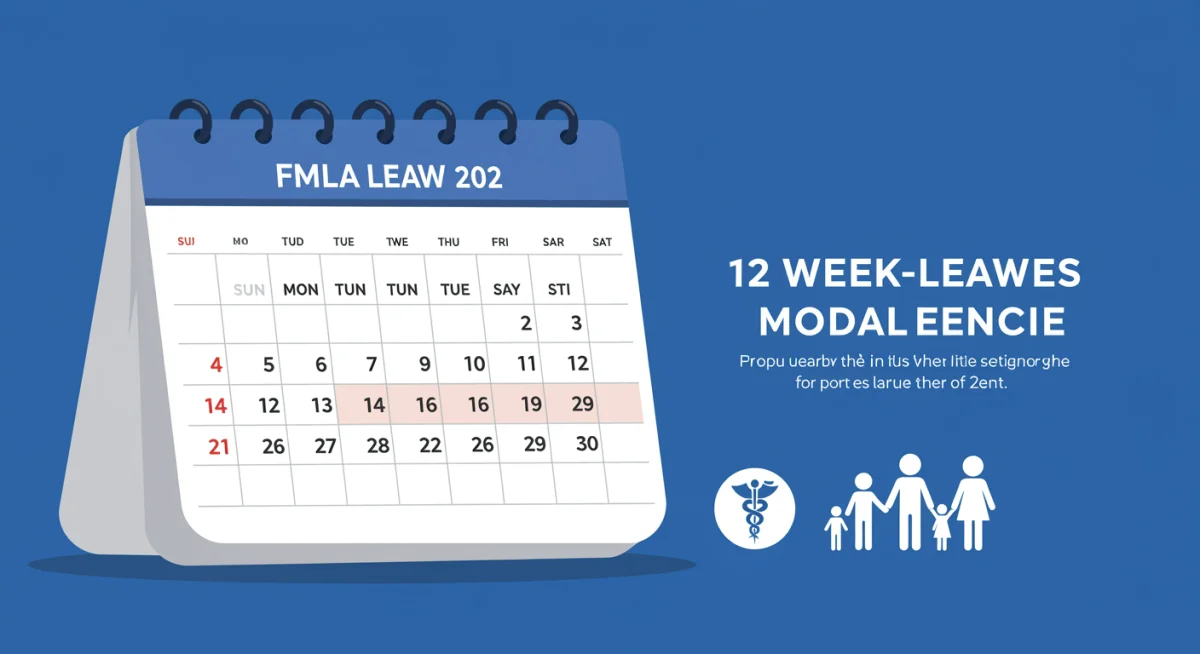New FMLA Interpretations: 12-Week Leave Eligibility Updates

Recent FMLA interpretations significantly impact 12-week leave eligibility, requiring employers and employees to understand updated criteria for qualifying absences and protected job returns.
Navigating the intricacies of the Family and Medical Leave Act (FMLA) can be a significant challenge for both employees and employers. The landscape of labor law is constantly evolving, and recent updates to FMLA interpretations have brought crucial changes, particularly concerning the criteria for FMLA 12-week leave eligibility. Understanding these new nuances is not just about compliance; it’s about ensuring fair treatment and maintaining a productive, supportive work environment. This article delves into what these changes mean for you.
Understanding the FMLA Framework for 12-Week Absences
The Family and Medical Leave Act (FMLA) is a federal law providing eligible employees with up to 12 workweeks of unpaid, job-protected leave per year for specific family and medical reasons. This foundational legislation ensures employees can take necessary time off without fear of losing their jobs. However, the application and interpretation of these provisions are not always straightforward, leading to a continuous need for clarification and updates.
At its core, FMLA aims to balance the needs of the workplace with the critical personal and family obligations of employees. This balance is often tested by complex individual circumstances, which is why interpretations from the Department of Labor (DOL) are so vital. These interpretations help standardize how the law is applied across different industries and situations, ensuring a degree of consistency and predictability for all parties involved.
Key Eligibility Criteria for FMLA Leave
- Employer Size: Employers must have 50 or more employees within 75 miles for FMLA to apply.
- Employee Service: Employees must have worked for the employer for at least 12 months.
- Hours Worked: Employees must have worked at least 1,250 hours during the 12 months immediately preceding the leave.
Beyond these initial hurdles, the specific reasons for leave must also qualify under FMLA. These typically include the birth or placement of a child, caring for a spouse, child, or parent with a serious health condition, or the employee’s own serious health condition. Navigating these requirements demands careful attention to detail, as even minor deviations can affect eligibility. The framework is designed to protect employees during some of life’s most challenging moments, making accurate interpretation paramount.
In summary, the FMLA framework provides a critical safety net, but its effectiveness hinges on a clear understanding of its eligibility criteria and permissible uses. The 12-week protected leave period offers significant support, but only when applied correctly within the defined legal boundaries. Staying current with official interpretations is key to leveraging this important benefit effectively.
Recent Interpretations: What’s New for Leave Eligibility
The Department of Labor (DOL) periodically issues guidance and interpretations to clarify aspects of the FMLA, and recent updates have shed new light on various scenarios impacting FMLA 12-week leave eligibility. These interpretations are not new laws but rather official explanations of how existing regulations apply to emerging situations or common points of confusion. Employers and employees must pay close attention to these updates, as they can significantly alter how leave requests are managed and approved.
One area of focus in recent interpretations has been the definition of a ‘serious health condition’ and what constitutes ‘in loco parentis’ relationships. These clarifications aim to provide more concrete guidelines for situations that previously might have fallen into a gray area. For instance, the DOL has emphasized that routine medical visits, unless they involve ongoing treatment for a chronic condition, generally do not qualify as a serious health condition for FMLA purposes.
Impact on ‘Serious Health Condition’ Definition
- Clarity on Chronic Conditions: Emphasizes that periodic visits for chronic conditions, even if brief, can qualify if they require ongoing treatment.
- Distinction from Minor Illnesses: Reinforces that common colds, flu, or minor injuries not requiring extensive medical care are typically not FMLA-qualifying.
- Telehealth Services: Guidance on how virtual doctor visits can fulfill the ‘in-person’ visit requirement for certification.
Another significant aspect of recent interpretations involves the intermittent leave provisions. While FMLA allows for leave to be taken in separate blocks of time, or by reducing the employee’s usual weekly or daily work schedule, the proper tracking and management of such leave have often been a source of confusion. The DOL has provided clearer guidelines on documentation requirements for intermittent leave, aiming to prevent abuse while ensuring employees receive their entitled protections.
These recent interpretations underscore the DOL’s commitment to ensuring the FMLA remains relevant and effectively applied in today’s diverse work environments. For employers, this means reviewing existing policies and training HR staff. For employees, it means being aware of their rights and understanding the documentation required to support their leave requests. Staying informed is the first step toward successful FMLA compliance and utilization.
Defining a ‘Serious Health Condition’ Under FMLA
Central to FMLA 12-week leave eligibility is the concept of a ‘serious health condition.’ This term is often misunderstood, leading to disputes between employees and employers. The FMLA defines a serious health condition as an illness, injury, impairment, or physical or mental condition that involves inpatient care or continuing treatment by a healthcare provider. Recent interpretations have further refined these definitions, offering more precise boundaries.
Inpatient care means an overnight stay in a hospital, hospice, or residential medical care facility, including any period of incapacity or subsequent treatment in connection with such inpatient care. This is a relatively straightforward aspect of the definition. The complexity often arises with ‘continuing treatment,’ which can encompass several different scenarios, each with its own set of requirements.
Categories of Continuing Treatment
- Incapacity and Treatment: A period of incapacity of more than three consecutive calendar days and any subsequent treatment or period of incapacity relating to the same condition. This requires treatment by a healthcare provider at least twice, or once with a regimen of continuing treatment.
- Pregnancy or Prenatal Care: Any period of incapacity due to pregnancy or for prenatal care.
- Chronic Conditions: A chronic serious health condition that requires periodic visits for treatment by a healthcare provider, continues over an extended period, and may cause episodic incapacity.
- Permanent or Long-Term Conditions: A period of incapacity that is permanent or long-term due to a condition for which treatment may not be effective.
- Multiple Treatments: Any period of absence to receive multiple treatments by a healthcare provider for restorative surgery or for a condition that would result in a period of incapacity of more than three consecutive calendar days in the absence of medical intervention.
The critical takeaway from recent interpretations is the emphasis on objective medical evidence. Employers are generally allowed to request medical certification to substantiate a serious health condition. This certification must provide sufficient information for the employer to determine if the condition qualifies under FMLA. The DOL encourages clear communication between employers, employees, and healthcare providers to ensure that all necessary documentation is provided and understood.
Ultimately, a ‘serious health condition’ is not merely a subjective feeling of illness but a medically verifiable condition meeting specific regulatory criteria. Understanding these nuances is vital for both parties to ensure compliance and proper utilization of FMLA benefits.
Navigating Intermittent and Reduced Schedule Leave
Intermittent leave and reduced schedule leave are crucial components of FMLA, allowing employees flexibility when dealing with serious health conditions or family needs. These types of leave, however, are often the most challenging for employers to manage and for employees to understand fully. Recent FMLA interpretations have provided much-needed clarity on how to navigate these complex arrangements, particularly concerning FMLA 12-week leave eligibility.
Intermittent leave is FMLA leave taken in separate blocks of time due to a single qualifying reason. A reduced leave schedule changes an employee’s usual daily or weekly work schedule for a period of time, usually hours at a time. Both are designed to accommodate ongoing or episodic needs, such as chemotherapy appointments, physical therapy, or caring for a child with a chronic illness. The challenge lies in tracking these small increments of leave accurately and ensuring they are properly designated as FMLA-protected time.

Employer Responsibilities and Employee Rights
Employers have a responsibility to track intermittent leave meticulously. This includes maintaining accurate records of hours taken, ensuring that the total does not exceed the 12-week annual entitlement. They can require employees to provide reasonable notice for foreseeable intermittent leave and may temporarily transfer an employee to an alternative position with equivalent pay and benefits that better accommodates the recurring periods of leave.
Employees, in turn, have the right to take intermittent or reduced schedule leave when medically necessary. They must, however, make a reasonable effort to schedule treatment so as not to unduly disrupt the employer’s operations, subject to the approval of the healthcare provider. Communication is key here; employees should keep their employers informed of their needs and expected absences.
Recent interpretations have emphasized the importance of clear communication and documentation for intermittent leave. Employers should have robust policies in place for requesting and tracking such leave, and employees should understand their obligations regarding notice and medical certification. Properly managed intermittent and reduced schedule leave can be a powerful tool for retaining valuable employees while meeting their personal and family needs, all while staying within the bounds of FMLA regulations.
The Role of Medical Certification in FMLA Eligibility
Medical certification plays a pivotal role in establishing FMLA 12-week leave eligibility. It serves as the primary means by which employers can verify that an employee’s (or their family member’s) health condition meets the FMLA’s definition of a serious health condition. Without proper and timely medical certification, an employer may deny an FMLA leave request.
The FMLA permits employers to require medical certification from a healthcare provider to support a request for leave due to an employee’s or family member’s serious health condition. This certification must be provided in a timely manner, typically within 15 calendar days after the employer requests it. If the certification is incomplete or insufficient, the employer must notify the employee and provide them with an opportunity to cure the deficiency.
Key Aspects of Medical Certification
- Timeliness: Employees generally have 15 calendar days to provide certification after the employer’s request.
- Sufficiency: Certification must provide enough information to determine if the condition meets FMLA criteria.
- Second/Third Opinions: Employers can request a second opinion (at their expense) if they doubt the validity of the initial certification. A third opinion, binding on both parties, can be sought if the first two differ.
- Recertification: Employers may request recertification for FMLA leave, typically every 6 months or if circumstances change significantly.
Recent interpretations have reinforced the importance of clear communication between employers, employees, and healthcare providers regarding the information needed for certification. The DOL provides optional forms (WH-380E for employee’s serious health condition and WH-380F for family member’s serious health condition) that healthcare providers can use to ensure all necessary information is included. While these forms are optional, they are highly recommended as they cover all the required elements.
The process of obtaining and submitting medical certification can be daunting, but it is a necessary step to ensure that FMLA protections are properly granted. Employers must approach this process with fairness and respect for employee privacy, while employees must understand their obligation to provide accurate and timely medical documentation. Proper handling of medical certification is a cornerstone of effective FMLA compliance and management.
Employer Compliance and Best Practices
For employers, navigating the nuances of FMLA 12-week leave eligibility and its recent interpretations requires not just knowledge of the law but also a commitment to best practices. Compliance is not merely about avoiding penalties; it’s about fostering a supportive work environment and retaining valuable talent. Proactive measures can prevent misunderstandings and legal challenges.
One of the most critical best practices is to develop clear, comprehensive FMLA policies that are easily accessible to all employees. These policies should reflect the latest DOL interpretations and clearly outline eligibility requirements, application procedures, and employee and employer responsibilities. Regular training for HR staff and managers is also essential to ensure they are equipped to handle FMLA requests consistently and correctly.
Strategies for Effective FMLA Management
- Policy Review: Regularly update FMLA policies to align with current regulations and interpretations.
- Staff Training: Provide ongoing training for HR and management on FMLA requirements and proper handling of leave requests.
- Consistent Application: Ensure FMLA policies are applied uniformly across all employees and departments to avoid claims of discrimination.
- Record Keeping: Maintain meticulous records of all FMLA requests, approvals, denials, and leave taken.
- Communication: Foster open communication with employees regarding their FMLA rights and obligations.
Another crucial aspect of employer compliance is understanding the concept of ‘designation’ of FMLA leave. Once an employer has enough information to determine that a leave is FMLA-qualifying, they must designate it as such and notify the employee. This designation is critical, as it triggers FMLA protections. Employers cannot delay or refuse to designate qualifying leave, even if the employee does not specifically request FMLA. The responsibility rests with the employer to recognize and designate FMLA-qualifying absences.
By adopting these best practices, employers can create a framework that not only complies with FMLA regulations but also supports their employees during challenging times. This proactive approach minimizes legal risks, enhances employee morale, and ultimately contributes to a more stable and productive workforce. Staying informed and prepared is key to navigating the complexities of FMLA successfully.
Employee Rights and Responsibilities Under New FMLA Interpretations
Understanding their rights and responsibilities under the FMLA, especially in light of new interpretations, is paramount for employees seeking job-protected leave. The FMLA is designed to protect employees, but these protections are contingent upon the employee fulfilling certain obligations. Being informed about FMLA 12-week leave eligibility ensures employees can effectively utilize this critical benefit.
Employees have the right to take up to 12 weeks of unpaid, job-protected leave for qualifying reasons without fear of retaliation or job loss. This includes the right to return to the same or an equivalent position upon their return from leave, with the same pay, benefits, and other terms and conditions of employment. Employers are also required to maintain the employee’s group health benefits during FMLA leave as if the employee had continued to work.
Key Employee Responsibilities
- Provide Notice: Employees must provide timely notice of their need for FMLA leave. For foreseeable leave, 30 days’ advance notice is generally required. For unforeseeable leave, notice should be given as soon as practicable.
- Medical Certification: Submit complete and timely medical certification when requested by the employer to support the need for leave due to a serious health condition.
- Communicate Changes: Keep the employer informed of any changes in the duration or circumstances of the leave.
- Follow Company Policy: Adhere to the employer’s usual and customary notice and procedural requirements for requesting leave, unless unusual circumstances prevent it.
Recent interpretations have emphasized the importance of employee communication. While an employee isn’t required to explicitly mention FMLA when requesting leave, they must provide enough information for the employer to reasonably determine that the leave may be FMLA-qualifying. This means describing the reason for the absence, even if briefly, so the employer can assess its nature.
If an employee believes their FMLA rights have been violated, they have recourse through the Department of Labor or by filing a private lawsuit. However, the best approach is always to understand the rules upfront, communicate clearly with the employer, and ensure all required documentation is submitted. By actively engaging in the FMLA process, employees can protect their rights and ensure they receive the leave they are entitled to, allowing them to address personal and family needs without jeopardizing their employment.
| Key Aspect | Brief Description |
|---|---|
| Eligibility Updates | Recent DOL interpretations clarify criteria for employee and employer FMLA eligibility, affecting 12-week leave. |
| Serious Health Condition | Clarified definitions for what constitutes a serious health condition, including chronic and long-term illnesses. |
| Intermittent Leave | New guidance on managing and tracking intermittent or reduced schedule leave for FMLA-qualifying events. |
| Medical Certification | Emphasis on timely and sufficient medical documentation for FMLA leave requests. |
Frequently Asked Questions About FMLA 12-Week Leave Eligibility
To be eligible, an employee must work for a covered employer (50+ employees within 75 miles), have worked for at least 12 months, and accumulated 1,250 hours of service during the 12 months prior to the leave. These foundational criteria determine initial eligibility.
Recent DOL interpretations clarify that a ‘serious health condition’ covers inpatient care or continuing treatment. They distinguish between minor illnesses and those requiring ongoing medical intervention, including specific guidance on chronic conditions and telehealth services for certification purposes.
Yes, FMLA allows for intermittent leave or a reduced schedule for qualifying reasons. Employers must track these hours carefully against the 12-week annual entitlement. Employees should provide notice and work with their employer to schedule treatments to minimize disruption.
Employers are responsible for designating leave as FMLA-qualifying once they have sufficient information, even if the employee doesn’t explicitly mention FMLA. They must notify the employee of this designation within five business days, triggering FMLA protections and obligations.
If an employee believes their FMLA rights have been violated, they can contact the Department of Labor’s Wage and Hour Division to file a complaint. They might also consult an attorney regarding their options, which could include pursuing a private lawsuit to enforce their FMLA rights.
Conclusion
The evolving landscape of FMLA interpretations, particularly concerning FMLA 12-week leave eligibility, underscores the dynamic nature of labor law. For both employers and employees, staying abreast of these updates is not just a matter of compliance but a fundamental aspect of fostering a fair, transparent, and supportive workplace. Employers must commit to developing robust, up-to-date policies and providing continuous training for their staff to ensure consistent application of FMLA rules. Employees, in turn, have a responsibility to understand their rights, provide timely and accurate documentation, and communicate effectively with their employers regarding their leave needs. By adhering to these principles, organizations can navigate the complexities of FMLA with greater confidence, ensuring that employees receive the protections they are entitled to while maintaining operational efficiency. The ultimate goal is a workplace where critical personal and family needs can be met without compromising job security, contributing to a healthier and more productive workforce for all.






